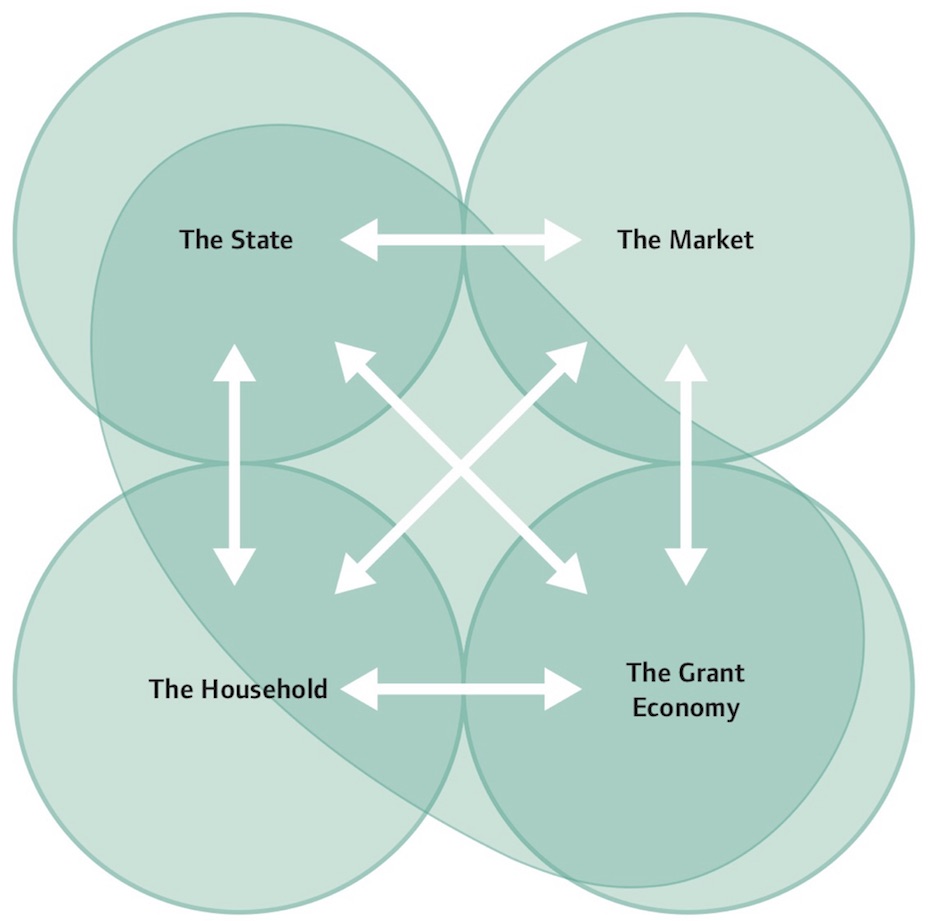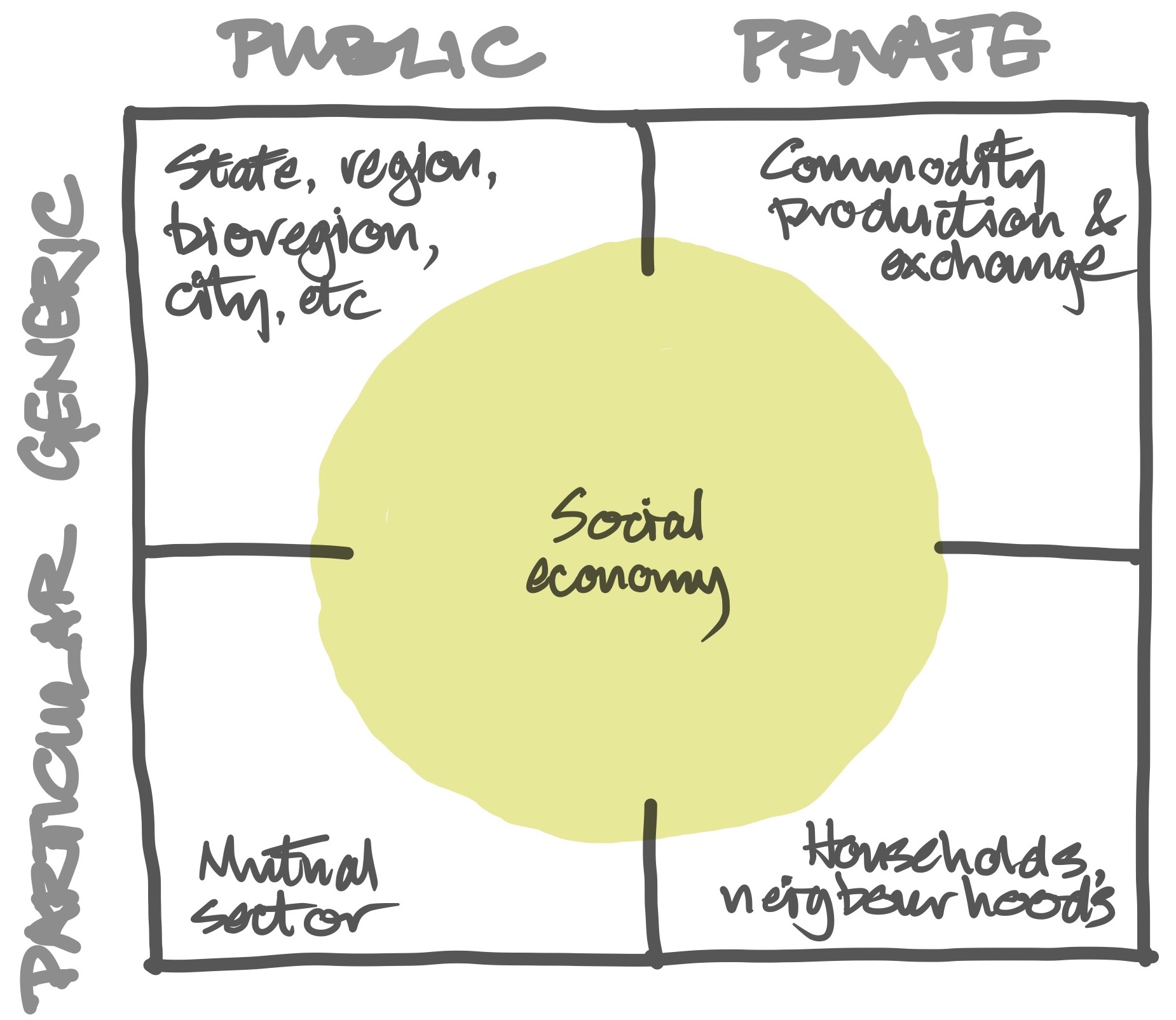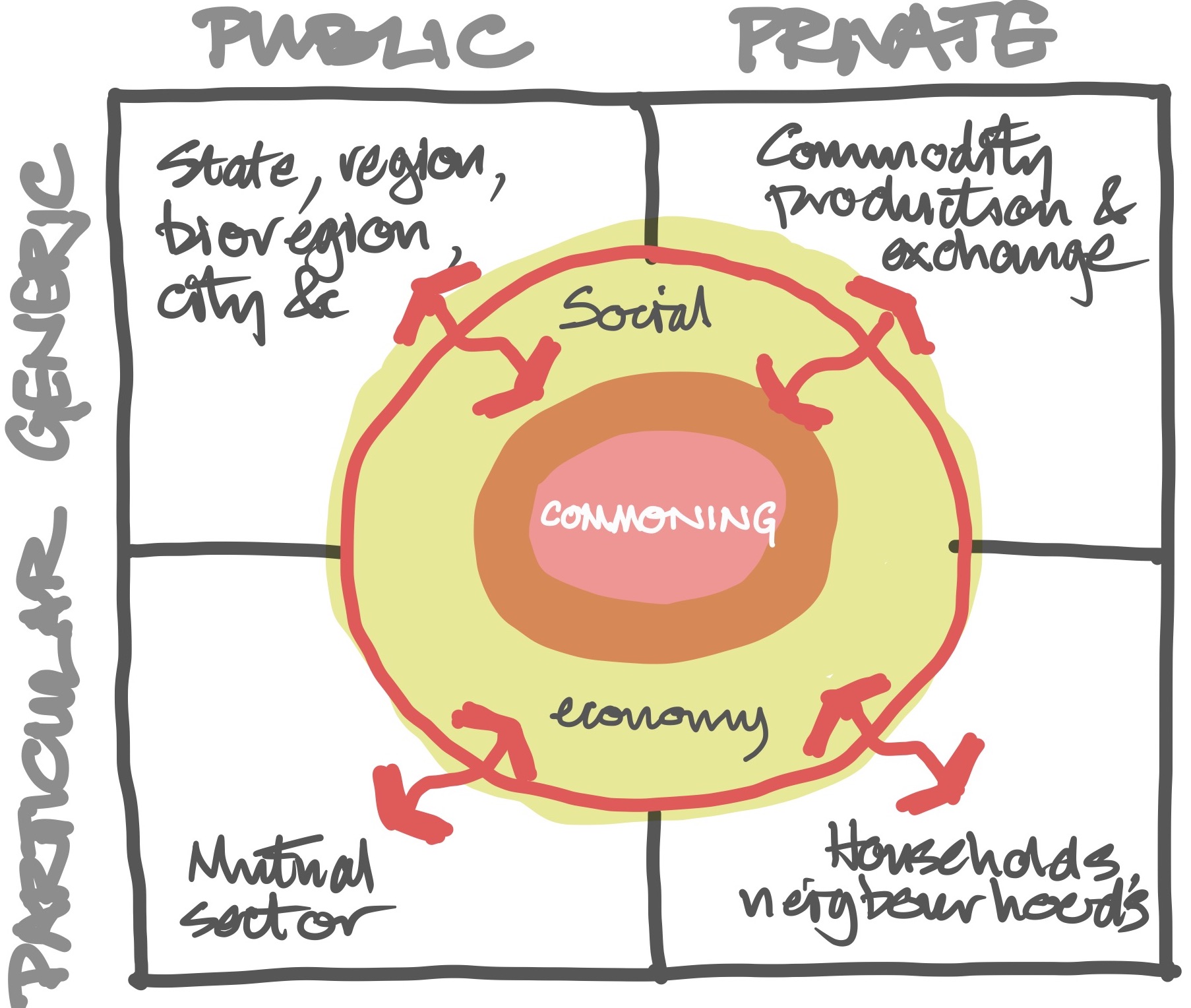In *Danger and opportunity* Robin explores the changing nature of ‘the real economy’ of material provisioning (‘use-value’, as the tradition calls it) and uses a schema that carries far more significance, I think, than he gave to it there. How it works and how it needs to be mobilised is too much to develop here but the bones are as follows.
He proposes a frame of ‘four economies’ - a public economy (State), a commodity economy (market), an informal intimate economy of family and friends (household) and a fourth which he tagged ‘the grant-funded economy’.

Four economies - DaO original
This last was a terrible misnomer it seems to me, far too narrow in its implications, and misleading by being funding focused.
I sat with this a long time, and in due course ended up with the typology reframed more systematically, on two axes, with two of the ‘economies’ renamed/reconceptualised. It’s now an analytical ‘space’ rather than a typology or lexicon, and this is how it looks:

Four economies from DaO - Analytically reframed
The axes are public/private and generic/particular (interpreted in quite broad ways) and ’state’ has been reframed as region/bioregion/municipality/urban hub/state. Most important, the ‘grant-funded economy’ has been reframed as *the mutual sector*: the entirety of civil-society action, not only - or even primarily - economic but also fundamentally *cultural*.
Historically, since the mutual sector began to emerge in the C18 - as the making of the working class \[Thompson 1963 xxxx] - its force has been centrally in the re-visioning, re-languageing and re-organising of ‘society’ (as addressed for example in Raymond Williams’ ‘culture and society’ oeuvre \[Williams 1960 xxx]) and in the creation of formations, genres of practice, that constitute . . working-class culture, black culture, movements of indigeneity, formations of women: forms of resistance and identity and *life-practice*. The pivotal mutual sector is at the heart of the dynamics that Robin uses his original schema to tabulate; and it is far larger than ‘economic’.
Over these four economies Robin lays an emerging ‘new social economy’ but the thing that isn’t identified in DaO is that the ‘newness’ of the practices in that constellation lies in the alteration of some *relations of production* that are dominant in the hegemonic forms of the four ‘old’ economies. - The separation of state decision apparatus and bureaucracy, and hands-on ‘making’ in community action, is altered in some ‘partner state’ participatory-circle service-design collaborations \[Cottam xxx]. - Ownership of means of production is formally modulated in coops (although bureaucratic division of labour often still operates, the owner-worker must still survive as a consumer in a hegemonic commodity economy and the enterprise generally must compete in it). - Professionalised enclosure and commodity journal publishing are dispensed with in wikis. And so on.

The dance of provisioning - Four 'grand sectors' of the real economy
**New economy - altered relations of production** What Robin’s map is actually mapping - in this revised four-quadrant form - is not forms of *revenue* (which is how the typology in DaO is presented) but diverse relations of *production*: the closer to the outside, the more currently-dominant the RoPs, and the closer to the centre, the more altered-emergent.
Production rather than revenue is, of course, where a labour-process approach would start; and relations of production, in turn, determine how revenue (among other things) is available to actors - assuming that money is part of the flow. Under some relations of production it would not be, which is one of the features and challenges that ‘the grant-funded economy’ in Robin’s formulation was hiding: the frequently - characteristically - ‘voluntary’ nature of the contribution, the provision.
Different, distinctive relations of production in the public-particular economy (aka mutual sector) are characteristic, as distinct from than the grant-funding of a minority of the practice in that quadrant.
**Commoning and dual power** In the reframed version of the schema, with relations of production rather than revenue as the basis of the mapping, ‘commoning’ sits at the centre.
Production of-and-in commons moves beyond the liberal-democratic state, beyond the capitalist commodity market, beyond the consumerist household; commoning is a massive, self-conscious mobilisation of the aesthetic that informs and animates the mutual sector: particularistic provision for everyday life of actual communities, freely contributed and freely available, organised under explicit, explicitly mutualised, direct community stewardship (thus, unlike a household or family).
To put commoning in the centre of the mapping space makes it clear: this is a space within which to consider what dominant relations of production are being displaced by altered relations of production, in quote-unquote ‘new’ economy; and what altered practical relationships there then are in the ‘dance of provisioning’ across the public and private, the generic and the particular.
The mapping space is thus deeply historical. What’s in the top-left quadrant need not be ‘the state’; it could be bioregion. What’s in the top-right need not be capitalist global commodity economy running on commodity money; it could be farmers’ market running on mutual credit, it could be Fairtrade. And so on.
The schema is thus a space in which to map of a dance of altered relations of production and *dual power*. This schema furnishes the aRoP element for landscape §1: provisioning of material means of subsistence and wellbeing. aRoPs need theorising - putting into explicit, structured, conceptualised frames - or they will slip out of our grasp and our memory and our dance, and yesterday will wreak itself upon tomorrow . . again.